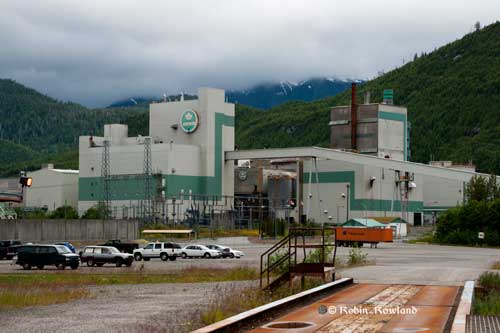The outlook for Pacific Northern Gas issued by Canada’s Dominion Bond Rating Service on Friday not only gives an indication of the financial health of the company, it also gives a window into what the financial markets think of the prospects for Kitimat and the region,
DBRS gave Pacific Northern Gas “Secured Debentures and Cumulative Redeemable Preferred Share ratings… BBB (low) and Pfd-3 (low), respectively, both with Stable trends,” DBRS said a news release dated June 10, 2011.
DBRS says that like all utilities, PNG has a stable financial outlook, but “it still has a higher level of business risk when compared with other DBRS-rated utilities.”
The DBRS report goes on to say:
Economic conditions in PNG’s Western system remain weak, but are showing signs of improvement, albeit at a slow pace. Signs of economic improvement in the region include Rio Tinto Ltd.’s (Rio Tinto) announcement of an additional $300 million investment on preconstruction activities for the US$2.5 billion proposed modernization of its aluminum smelter in Kitimat, B.C.; the proposed Phase 2 of a new container handling facility at the Port of Prince Rupert; and continued modest growth in the oil and gas sector in the Northeast system area.
The closure of the West Fraser Kitimat [Eurocan] paper mill in 2010 resulted in some loss of customers in the region, which was offset by the increase in customers in the Northeast system service area. Despite the challenges in the Western system area, PNG has been able to maintain a stable customer base.
In the longer term, the competitiveness of natural gas as a fuel and heating source still remains a key focus for PNG, especially in the Western service area; however, residential and commercial electricity rates are expected to rise in the near term according to BC Hydro’s Service Plan. The proposed electricity price increase and current low gas price environment are expected to keep PNG’s delivered natural gas rates competitive with electricity rates in PNG’s Western system.
DBRS also liked the fact that much of the money paid by the KM LNG partners for the Pacific Trail Pipeline was supposed to go PNG shareholders:
In March 2011, PNG completed the sale of its 50% stake in Pacific Trail Pipelines Limited Partnership (PTP) for a gross consideration of $30 million. The Company has declared special dividends of approximately $22 million, which represents all of the initial payment. A final cash payment of $20 million will be paid if the purchasers make a decision to proceed with the construction of the Kitimat LNG export facility in British Columbia.
There is no guarantee that the final payment will be made.
Going forward, if the net proceeds from the second payment are retained and reinvested in the Company, this could have a longer-term positive impact on PNG’s creditworthiness. However, the extent of any credit impact will depend entirely on the amounts to be retained and how they are reinvested.
But as the Northern Sentinel reported, the BC Utilities commission wasn’t so happy with the dividend, especially when it came to the PNG “transportation charges” it levies on consumers and businesses. The Sentinel says Pacific Northern Gas agreed to pay $500,000 toward the transportation charges to avoid a court fight with the BCUC, after the commission questioned why PNG was not passing on some of the money from the sale to lower the charges.
It should be noted that $500,000 is just six per cent of the $30 million net proceeds PNG received for the sale.
In the long term, the DBRS report says: “increase[d] utilization on its Western system, [has] the potential to increase PNG’s margins and lower the average cost of transporting gas for all customers.” “Increased utilization” likely refers to the various liquified natural gas projects that may make further use of PNG facilities.
DBRS says that PNG expansion and diversification plans could eventually lower its financial market risk profile:
“through electricity and renewable energy generation. In 2010, it acquired the 9.8 MW McNair Creek “run of river” hydroelectric generation facility in British Columbia for $17 million. It also recently formed Narrows Inlet Limited Partnership with Skookum Power Corp. to undertake an investment of up to $2.5 million to advance the Narrows Inlet Project to the start of construction. The $190 million project was awarded a 30-year energy purchase agreement with British Columbia Hydro & Power Authority (BC Hydro) in spring 2010.”
As some energy executives have come to realize, but others have ignored, high PNG natural gas transportation charges are one main reason that the industry is mistrusted, if not hated, across the political spectrum from right to left in northwestern BC, a political constituency that goes far beyond the environmental activists.
At every public meeting on energy and pipeline issues, there are always questions about the PNG transportation charges, even at meetings on the Enbridge bitumen pipeline, which has little do with the natural gas charges here (although Enbridge is a major consumer natural gas supplier in eastern Canada).
At the information meeting in Kitimat earlier this summer, Thomas Tatham, managing director of BCLNG Energy Co-operative, which hopes to build the second LNG terminal near Kitimat harbour, promised that his company, using PNG lines, would absorb the transportation charges for Kitimat consumers.
 The United States National Marine Fisheries Service has extended the deadline for comments on its controversial Halibut Catch Sharing plan by 15 days until Sept. 21.
The United States National Marine Fisheries Service has extended the deadline for comments on its controversial Halibut Catch Sharing plan by 15 days until Sept. 21. The closed Eurocan plant in Kitimat, the day it was sold, July 14, 2011. (Robin Rowland/Northwest Coast Energy News)
The closed Eurocan plant in Kitimat, the day it was sold, July 14, 2011. (Robin Rowland/Northwest Coast Energy News)